Family : Scombridae

Text © Giuseppe Mazza

English translation by Mario Beltramini
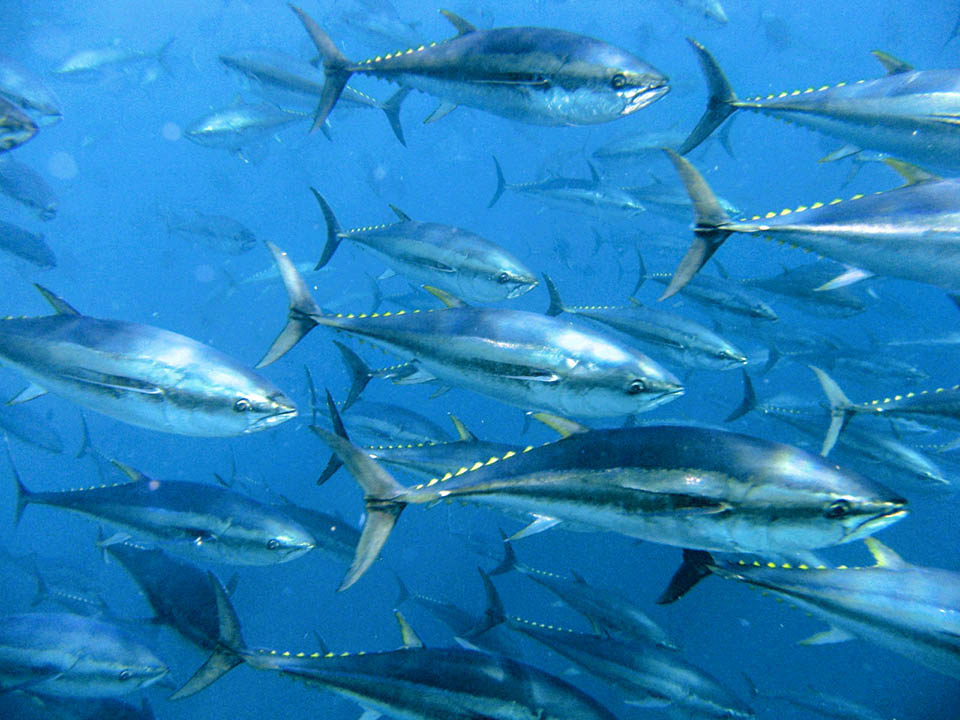
Present on both Atlantic sides, the Atlantic bluefin tuna (Thunnus thynnus) moves in schools on big distances covering even 200 kg per day © Tom Puchner
The Tunny or Atlantic bluefin tuna (Thunnus thynnus Linnaeus, 178), called in Red tuna due to the bloody colour of its flesh, belongs to the class Actinopterygii, the ray-finned fishes, to the order Perciformes and to the family Scombridae, that counts 15 genera and 54 species.
The original name given by Linnaeus was Thynnus thynnus, from the Greek “thynnos”, tuna, but in 1816 Cuvier changed it to Thunnus, because Thynnus had been already used in 1775 by Fabricius for a hymenopteran.
Also the vulgar mane has been changed. Nowadays, to be precise, this fish, once considered as cosmopolitan, would be called Atlantic red tuna to distinguish it from the similar Pacific bluefin tuna (Thunnus orientalis) recently distinguished as species by Collette in 1999.
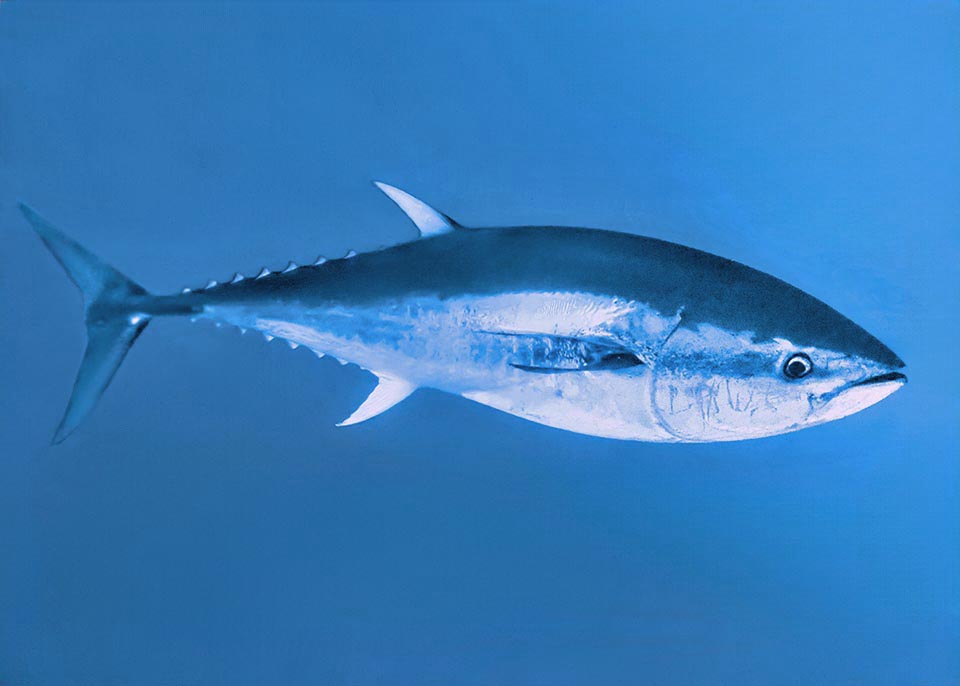
May reach 458 cm in length and 684 kg, but the current size is about 2 m. The second dorsal fin and the anal are always visible © Sylvain Le Bris
Zoogeography
Hence Thunnus thynnus lives on both sides of the Atlantic.
On the eastern one it is present from the Lofoten Islands, off Norway, up to Canary Islands, the Mediterranean and the southern part of the Black Sea. Finally, it is reported in Mauritania and in South Africa.
On the American side it is found from Canada to the Gulf of Mexico, then in the Caribbean, along the coasts of Venezuela and off Brazil where however, due to the excessive fishing it has almost disappeared.
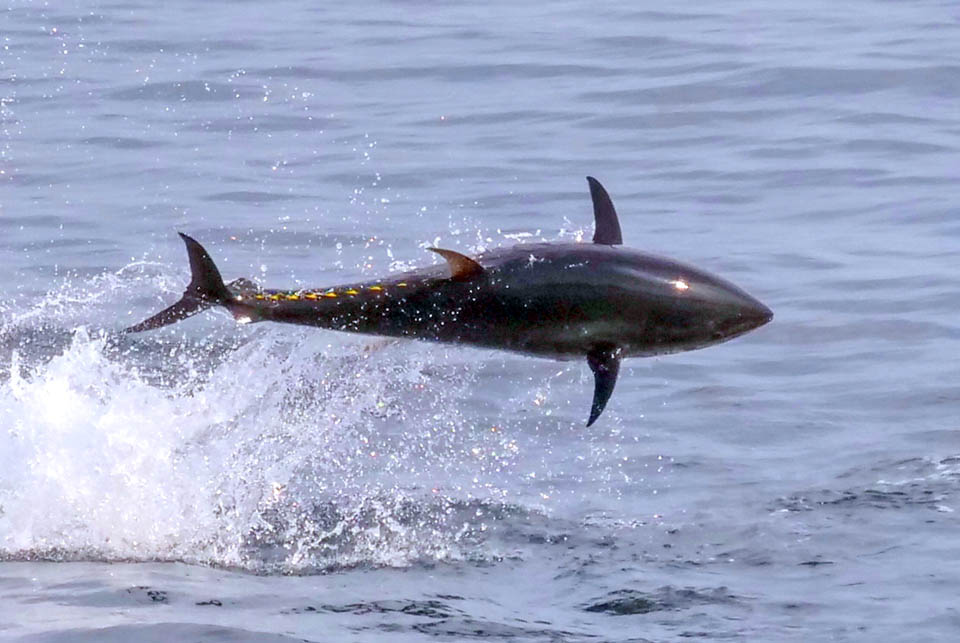
It can move at 90 km/h and spectacular leaps out of the water do not lack. Here we note well the pectoral fins normally bent for a perfect hydrodynamic profile © redhat
Ecology-Habitat
Thunnus thynnus is a subtropical pelagic-oceanic fish, who accepts temperatures standing from 3 to 30 °C and moves over enormous distances, travelling up to even 200 km a day, in schools advancing at 6-20 km/h, with peaks of 90, looking for preys or for reaching, every year, with the same routes, the locations chosen for centuries for their reproduction.
Usually, they swim between the surface and the depth of 100 m, going down exceptionally, up to about 1.000 m.
Morphophysiology

This pursues perhaps vigorously a school of mackerels or flying squids that were moving in surface © Thomas Stjernegaard Jeppesen
Even if the normal size is around 2 m, the Atlantic bluefin tuna can reach the length of 458 cm and a maximum reported weight of 684 kg.
The stocky, fusiform body, longer in the juveniles, is potbellied in the adults, with the maximum height towards the middle of the first dorsal fin.
The very strong skin is formed by 6 layers of connective tissue with fibres arranged alternatively perpendicular to the previous layer. The operculum is bare and the scales are very small and smooth.
The livery is dark steel blue colour on the back, at times almost black, bluish on the sides and silvery white towards the belly.
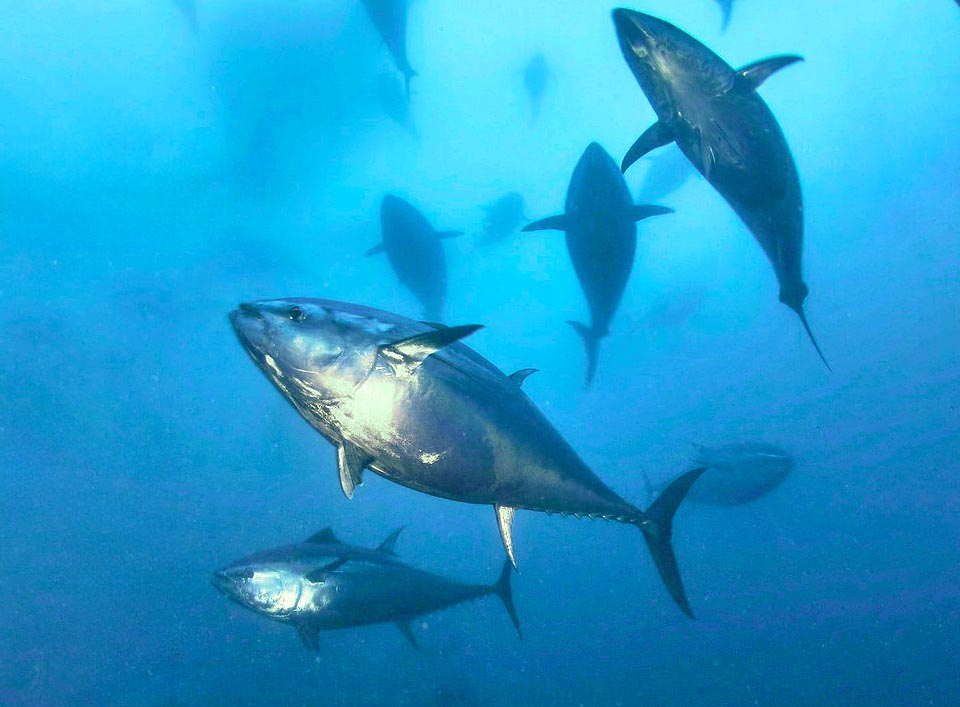
Its worst enemy is man who always preyed on it and has led it almost to extinction awaiting with the modern fishing techniques in the sites where it reproduces © Antonio Martin
The juveniles are characterized by pale vertical streaks on the sides that fade with the growth leaving the place to a spotty hatching, well visible in the adults when just fished but that disappears with their death.
There are 2 closely spaced dorsal fins having totally 12-14 spiny rays and 13-15 soft.
The first one can bend backwards and disappear completely into a dedicated groove. The second, followed by 8-10 triangular pinnulae, and similar to the anal fin, also flanked by 7-9 pinnulae.
The pelvic fins, located under the pectoral ones, are short with 6 rays and a short bifurcated bony process.
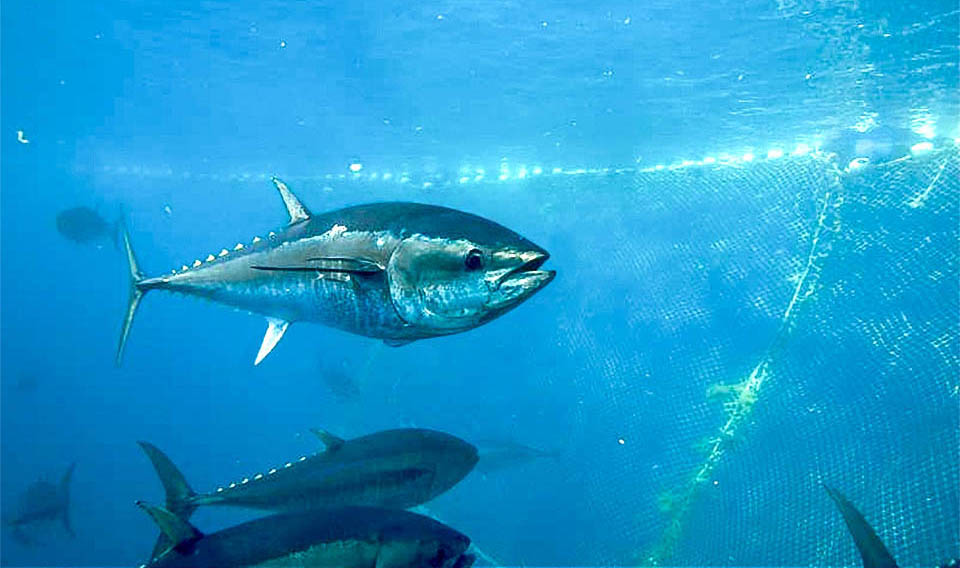
To save it from the dangers of seines and from the floating trawls that catch hundreds of breeders in one go, in 2010 the Principality of Monaco has been the first Nation to move for the protection of the species, proposing its inscription into the CITES Appendix I that forbids the international trade of endangered animals © OCEANA – Keith Ellenbogen
The caudal peduncle, robust and thin, in the adults has a long central black keel and two smaller at the base of the tail. The caudal fin, deeply bifurcated as befits fast swimming fishes, is the powerful propulsion organ.
The pectoral fins, rather short, less than 80% than the length of the head, have, like the first dorsal, a groove where to bend during the fast swimming thus ensuring a perfectly hydrodynamic profile.
The mouth, terminal, is fairly modest with only one row of small conical curved teeth slightly pointed assisted by others, similar, placed on the vomer and the palatines.
As usually happens for the Scombridae, the sexual dimorphism is not evident.
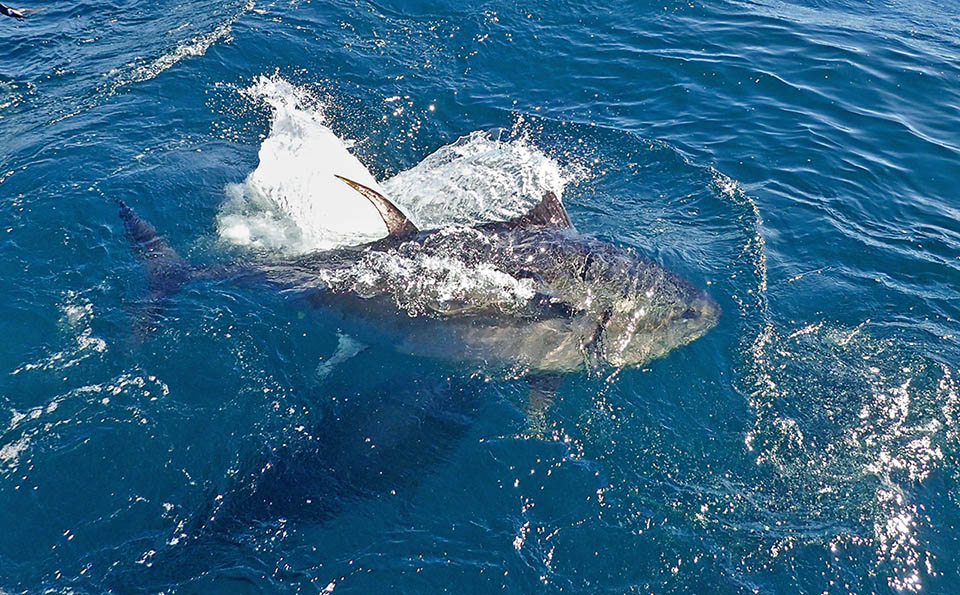
It was not accepted but served to raise global public awareness and the fishing quotas were reduced. Even now the Prince Albert II of Monaco follows closely the species with a marking programme of the Atlantic bluefin tuna with satellite radio beacons in the “Pelagos Sanctuary”, a vast Mediterranean zone for the protection of the cetaceans © Laurel Amirault
Ethology-Reproductive Biology
In their early days the juveniles of Thunnus thynnus feed mainly on zooplankton and on small coastal pelagic fishes. The subadults grow up hunting bigger pelagic fishes, shrimps and cephalopods that constitute the main course of the adults together with the Atlantic mackerel (Scomber scombrus), the Atlantic herring (Clupea harengus) and the European flying squid (Todarodes sagittatus), but in the stomach of the Atlantic bluefin tunas have been found the leftovers of 36 different species depending on the sites where they do live.
In fact, there are two populations of Thunnus thynnus that nowadays display also some genetic differences: that of the eastern Atlantic that migrates to reproduce from North Europe to the Mediterranean through Gibraltar Strait, and that of the western Atlantic, with lower biomass, that reproduces mainly in the Gulf of Mexico.

Young subadult at its first experiences. It’s recognized at once due to the second dorsal fin shorter and the vertical bands on the sides that will disappear with the age © silviodavison
Fishes hunted in their paths like in the Mediterranean with the traditional slaughter in the tuna fisheries and especially with modern seines and floating trawls that commit real massacres killing the reproducers on one way, when their flesh is fatty and tasty, whilst in the returning wave has a significantly lower nutritional and commercial value because the tunas stop feeding during the reproduction time.
These malpractices have seriously endangered the species with a growing demand in the post-war Japanese market ready to pay any price for preparing sashimis and sushis.
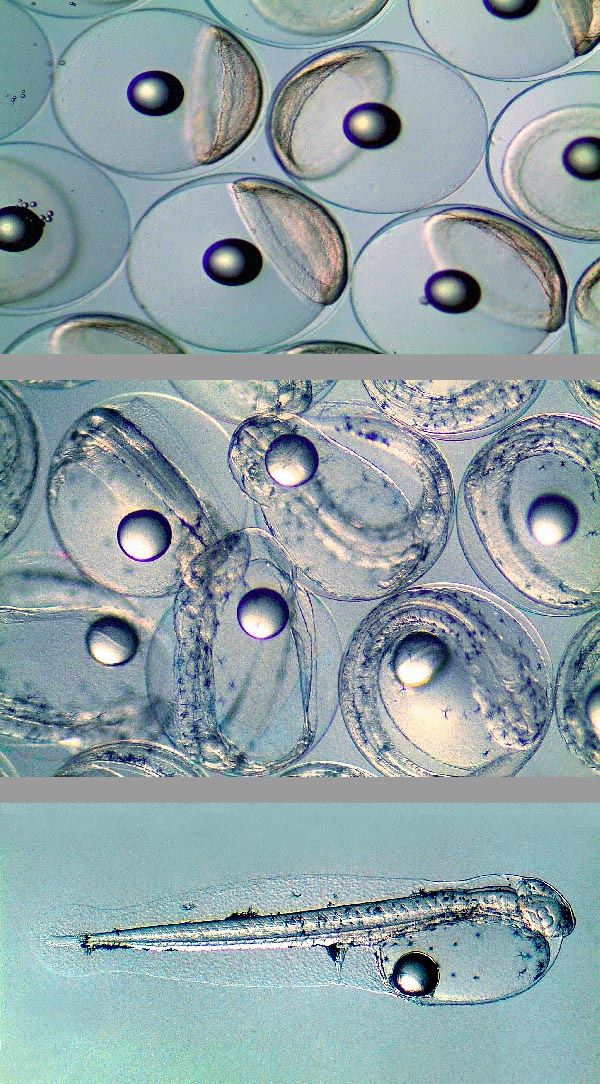
Freshly laid eggs, the hatching and a young embryo © Fernando de la Gandara (IEO)
It is sufficient to think of the auction of January 5th, 2011, when a 432 kg Atlantic bluefin tuna was awarded at an auction for the unbelievable amount of 300.000 Euros.
Since its creation, the Prince Albert II of Monaco Foundation has worked for the conservation of the Thunnus thynnus, and Monaco has been the first State to mobilize for the international protection of the species.
So, in 2010, together with France, Monaco proposed the registration of Thunnus thynnus in the CITES Appendix I that, if adopted, would have banned its international trade.
Due to the support that enjoyed Japan that imports 80% of the catch, not to talk of the fishermen’s interests, the request was unfortunately rejected, but it raised global public awareness contributing to the reduction of the fishing quotas set by ICCAT, the International Commission for the Conservation of Atlantic Tunas for the conservation of the Atlantic tunas.
Even today, though the situation has improved to the point that in the IUCN Red List Thunnus thynnus appears with exaggerated optimism as “Least Concern”, we should not let our guard down and to know better and protect the sites of reproduction of the species the Principality of Monaco has implemented a marking programme of the Atlantic bluefin tuna with satellite radio beacons in the “Pelagos Sanctuary”, a vast zone of the Mediterranean for the protection of the cetaceans.
A quadrilateral that starting from the Gulf of Genoa includes Corsica up to Capo Falcone and Capo Ferro in Sardinia, touching Fosso Chiarone (Tuscany) and on the opposite side, the peninsula of Gens in France.
It is known that the Atlantic bluefin tuna reaches sexual maturity when 4 years old in the eastern Atlantic and when about 8 in the western Atlantic where in various locations it is in sharp decline or has disappeared.
In nature it is preyed by the Killer whale (Orcinus orca), by the Shortfin mako shark (Isurus oxyrinchus) and the Long-finned pilot whale (Globicephala melas) but it might live, not caught, from 20 to 50 years.
In the Mediterranean the laying occurs between June and August at the Balearic Islands, in southern Tyrrhenian and in the Maltese waters, plus eastern Sicily.
The fecundated eggs float because they contain, as is the case for many species, an oily bubble that carries them immediately up to the surface entrusting them to the currents.
The larvae hatch after two days, the larval planktonic stage lasta about one month and in the first times we note long spines on the gill operculum.
The growth is extremely rapid, and when one year old the fish already measures 70 cm with a weight of 3-5 kg.
The resilience is average, with a minimum time for doubling the populations of 1,4-4,4 years, but the fishing vulnerability, still very high, marks 82 on a scale of 100.
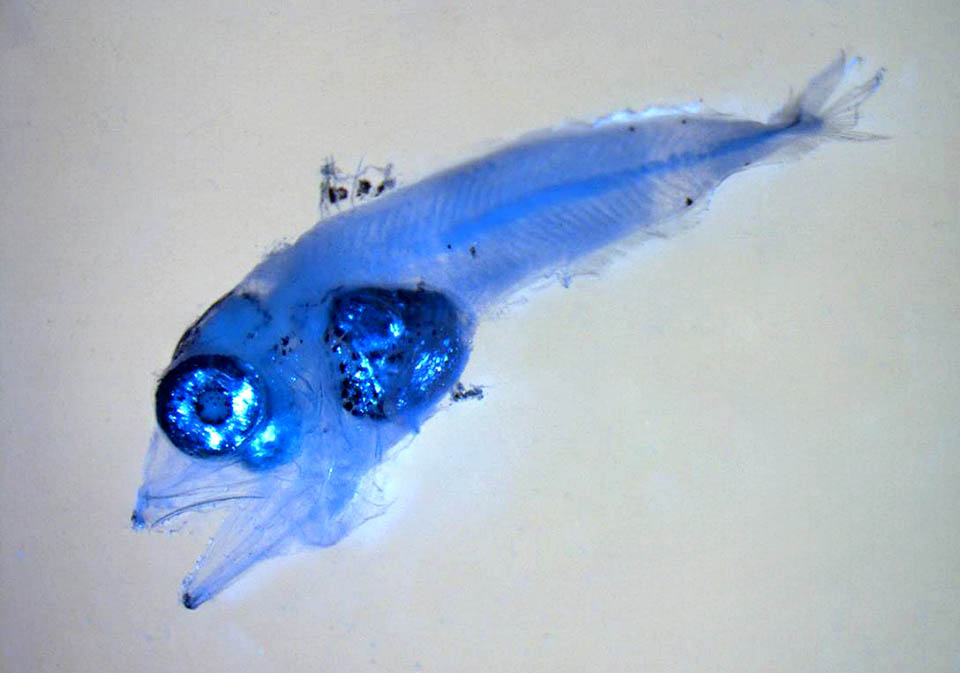
Here it measures about 5 mm. To save it they have thought even to fish farming but this is too expensive as for increasing of 1 kg a captive tuna this needs 10 kg of fish © OCEANA – Patricia Lastra
It is estimated that the 2 m females have a fertility of 30-60 million of eggs per season in the western Atlantic and 13-15 million in the eastern one, and so it has been thought also to the breeding in fish farming, but for increasing a tuna of 1 kg in captivity the same should eat 10 kg of fish, and besides the cost the quality of the flesh might be lower than that of the wild tuna.
It is therefore better to deepen the knowledge of the species by protecting their reproductive movements, to establish fishing quotas and to fight against poaching.
Synonyms
Scomber glauciscus Pallas, 1814; Scomber vernalis Mitchill, 1815; Scomber vulgaris Fleming, 1828; Scomber vulgaris Wood, 1837; Scomber scriptus Couch, 1863.
→ For general information about FISH please click here.
→ For general information about BONY FISH please click here
→ For general information about CARTILAGINOUS FISH please click here.
→ To appreciate the BIODIVERSITY of BONY FISH please click here.
→ To appreciate the BIODIVERSITY of CARTILAGINOUS FISH please click here.
